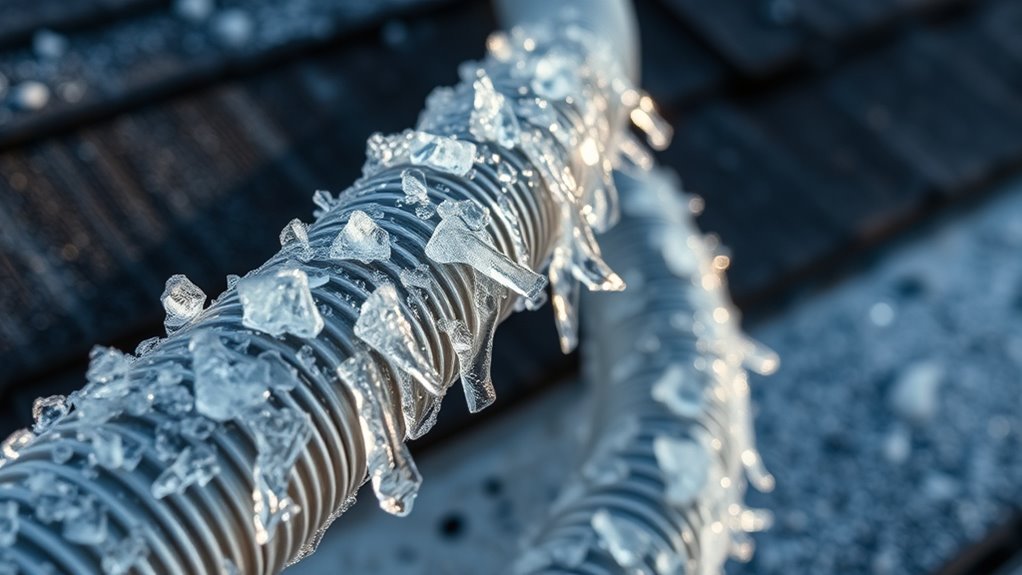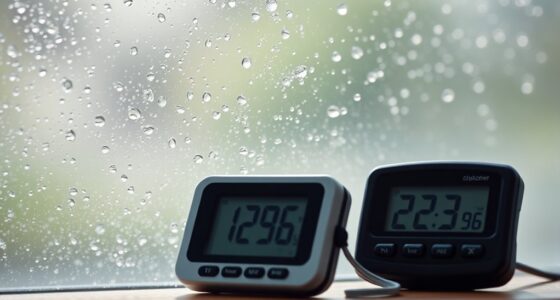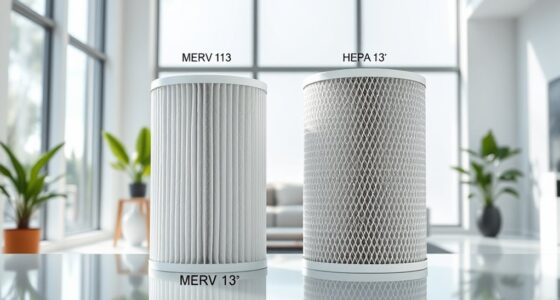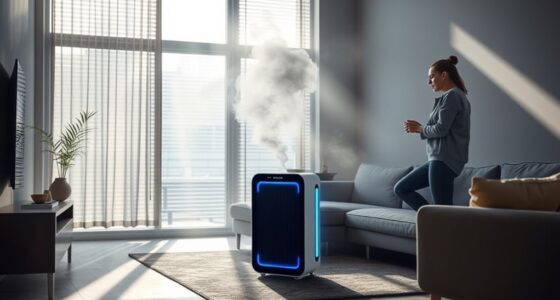Ice on your AC lines usually signals issues like poor airflow, insulation problems, or moisture entering electrical parts, which can cause system damage or failure if ignored. You should turn off your outdoor unit and let the ice melt safely, then inspect for damage or insulation leaks. If the ice persists or covers a large area, contacting a professional HVAC technician is essential. Keep your system well-maintained to prevent recurring problems—learn more to protect your unit effectively.
Key Takeaways
- Ice on AC lines indicates insulation issues, moisture ingress, or system malfunction, requiring prompt inspection.
- Determine if the ice is localized or widespread to assess severity and necessary action.
- Turn off the outdoor unit and allow ice to melt naturally, especially in warm weather forecasts.
- Check for damaged insulation or debris blocking airflow that may cause icing.
- Contact a professional HVAC technician if ice persists or extensive, to prevent system damage.
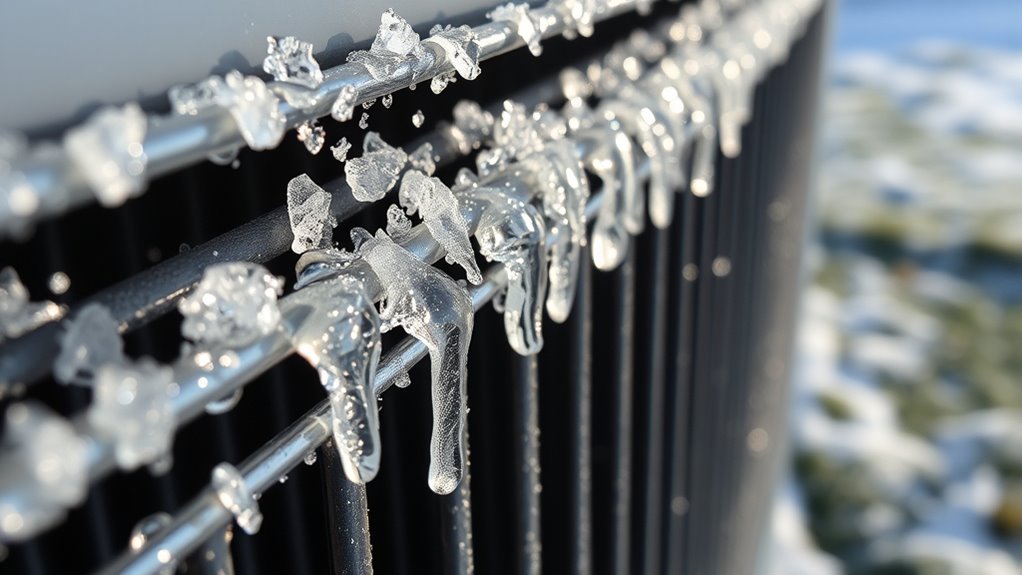
During winter storms, ice can quickly build up on AC power lines, creating serious safety and reliability concerns. If you notice ice forming on your outdoor AC unit or the nearby power lines, it’s essential to understand what it means and how to respond effectively. Ice accumulation can indicate underlying issues that might compromise your system’s performance and safety. One common problem is insulation issues, which can cause moisture to seep into electrical components, leading to ice formation. When insulation isn’t properly maintained or has been damaged, it exposes wiring and other parts to cold air and moisture, increasing the risk of ice buildup. This ice can weigh down the outdoor unit, strain electrical connections, and potentially cause short circuits or system failures.
Ice on outdoor AC units signals insulation issues and potential system damage during winter storms.
If you see ice on your outdoor unit, the first step is to evaluate whether the icing is localized or widespread. Small patches might be temporary and melt away once the weather warms up, but extensive ice buildup suggests a more serious problem. It could mean your unit isn’t defrosting properly, perhaps due to a malfunctioning defrost cycle or blocked airflow. Also, check the surrounding area for insulation issues—if insulation around the unit or nearby wiring is damaged or insufficient, it allows cold air and moisture to penetrate, promoting ice formation. Ensuring proper insulation can prevent this issue from recurring and protect your system during harsh weather. Additionally, high-quality insulation can help maintain optimal operating conditions and reduce the likelihood of ice buildup.
Responding to ice on AC lines involves a cautious approach. Never attempt to chip away at ice with sharp tools, as this can damage the unit or electrical connections. Instead, turn off the outdoor unit and disconnect it from power if safe to do so. Allow the ice to melt naturally, especially if the weather is expected to warm up. Once the ice melts, inspect the unit and wiring for any signs of damage or corrosion, which might have been caused by moisture infiltration due to insulation issues. If you notice persistent icing or damage, it’s best to contact a professional HVAC technician. They can assess whether your insulation needs repairs, check for refrigerant or defrost system problems, and ensure your outdoor unit is functioning correctly.
Regular maintenance can help prevent these issues from escalating. Keep the outdoor unit free of debris, ensure insulation around wiring and components is intact, and schedule seasonal inspections. By addressing insulation issues early and monitoring ice buildup, you can safeguard your system’s efficiency and avoid costly repairs. Remember, ice on AC lines is not just a minor inconvenience—it’s a signal that something’s amiss. Acting promptly and responsibly will help keep your system safe, reliable, and ready to handle the winter weather.
Frequently Asked Questions
Can Ice on AC Lines Cause Electrical Fires?
Ice on AC lines can increase electrical hazards and fire risks. When ice forms, it can cause wires to become brittle or damaged, leading to short circuits or sparks. These electrical hazards can ignite nearby materials, potentially causing fires. To prevent this, you should regularly inspect your AC lines, remove ice carefully, and call a professional if you notice persistent ice buildup or damage, ensuring safety and avoiding fire risks.
How Long Does It Take for Ice to Melt Naturally?
Like a slow-burning story, ice melting naturally can take anywhere from a few hours to a day, depending on ambient temperature and sunlight. When the weather warms, the natural process begins, and the ice gradually turns to water. If you keep the area warm or remove the ice promptly, it speeds up melting. Patience is key, but understanding that the process varies helps you better anticipate when it’ll fully melt away.
Is Ice on AC Lines Safe to Touch?
You should avoid touching ice on AC lines because there are safety concerns, like potential electrical hazards or damage to the unit. Instead, focus on troubleshooting steps such as turning off the AC, inspecting for leaks or blockages, and calling a professional if needed. Always prioritize safety, and don’t attempt repairs or contact with ice on the lines unless you’re qualified, to prevent injury or further damage.
Should I Turn off My AC if I See Ice?
You should turn off your AC if you see ice, as it’s a sign of potential refrigerant or airflow issues. Did you know that over 60% of AC malfunctions are caused by poor maintenance? Turning off the system guarantees service safety and prevents further damage. Once cooled, check filters and vents for blockages, and schedule professional maintenance tips to keep your system running efficiently and avoid future ice formation.
What Are the Long-Term Effects of Ice Buildup?
Ice buildup on your AC lines can cause long-term damage if ignored. It may lead to insulation damage, which affects energy efficiency, and refrigerant leaks that compromise cooling performance. Over time, these issues can increase your energy bills and lead to costly repairs. To prevent this, address ice promptly, guarantee proper airflow, and schedule professional maintenance regularly to keep your system running smoothly.
Conclusion
Just like a thin layer of ice can weaken a delicate branch, ice on your AC lines signals potential trouble. I remember a summer when a fallen branch caused a power outage; similarly, ice buildup can strain your system. Keep an eye on those lines—prompt action can prevent costly damage. Think of your AC lines as the backbone of your comfort; when they freeze, your home’s warmth is at risk. Stay vigilant, and your cool will stay intact.
